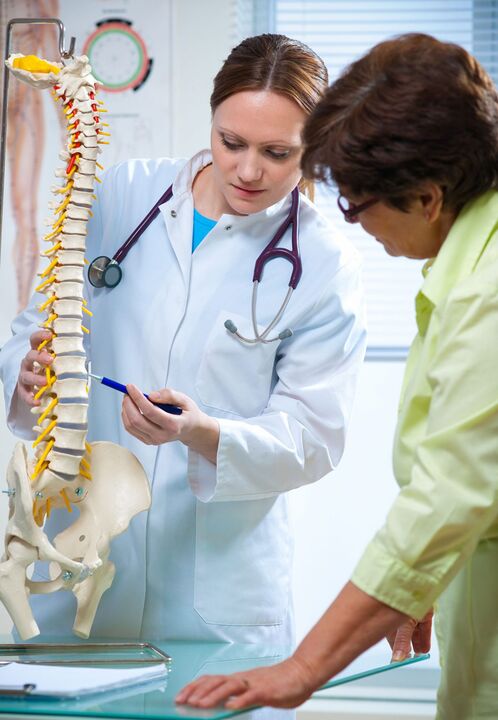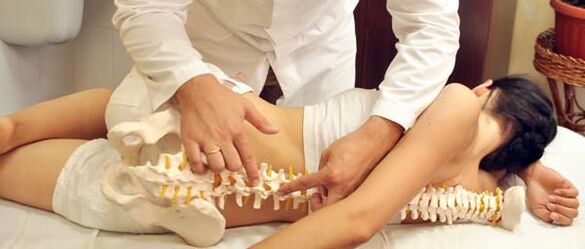Everyone has experienced back pain, many live with such pain all the time. In 2/3 of the cases the cause of back problems is osteochondrosis of the spine. With osteochondrosis, the bone and cartilage tissue of the spine - cervical, thoracic, lumbar spine - is destroyed. The risk of tissue wear increases with age, and every second inhabitant of the earth over 30 years of age shows signs of osteochondrosis.
Spinal diseases provoke back injuries, constant stress from hard physical work. Genetic predisposition, intensive training, poor diet, and lack of exercise play a role - most city dwellers are at risk.
How to recognize osteochondrosis

In osteochondrosis, the symptoms are general, specific and characteristic of degenerative changes in the articular cartilage, intervertebral discs and the tissues of the spine.
Osteochondrosis is manifested by constantly aching back pain, numbness of the affected vertebral sections, restricted mobility, increased pain with sudden movements, weight lifting.
Specific signs of osteochondrosis:
- the cervical type leads to circulatory disorders, provokes headaches, tinnitus, "flies" in front of the eyes. There are problems with the nutrition of the brain resulting in constant stress;
- with osteochondrosis of the chest region, intercostal neuralgia, pain in the chest, ribs develops;
- A disease of the lumbar spine causes the progression of diseases - lumbago, sciatica (sciatica), lumbar sciatica.
In sciatica, the sciatic nerve is affected. Symptoms include pain in the buttocks, calf hypotension, gluteal muscles.
Lumbago can be recognized by the sharp pain in the lower back caused by the displacement of the vertebrae, herniated disc.
With sciatica, there is lumbar pain in the buttocks area that occurs in the back of the thigh, lower leg, foot, and hollow of the knee.
Treatment of osteochondrosis
The clinical manifestations of osteochondrosis of the spine are different, sometimes you need to see different doctors to understand the cause of the disease. Correct diagnosis in some private clinics is made by a neurologist, an orthopedic surgeon - a vertebrologist, a vertebroneurologist, doctors who deal with diseases of the spine.

The doctor will report the primary diagnosis at the first exam when feeling the patient's back. Treatment is prescribed after x-rays, computed tomography, MRI.
The treatment of osteochondrosis of the spine aims to eliminate pain, prevent further tissue destruction and deformity of the spine.
Invertebrate osteochondrosis is a chronic disease, there are stages of exacerbation, remission. Treatment for spinal disease during the exacerbation includes bed rest for 1-2 weeks, pain medication is taken if the pain is severe.
With cervical osteochondrosis during the exacerbation, it is recommended to wear a special limiting collar. If the thoracic and lumbar spine are affected, a corset for the spine can help with exacerbations. Varieties of corset:
- for the chest area - a bandage that resembles a vest. It is used to straighten the spine;
- for spinal fractures - plaster of paris, extension corset;
- a rigid corset is worn after spinal surgery or injuries. Helps support internal organs when muscles are weakened;
- Corset in the form of a wide belt for the lumbar spine. Recommended for hernias, displacements.
Treatment of osteochondrosis of the spine should be comprehensive: drug treatment, exercise therapy, manual therapy, diet - conservative treatment. Sometimes operated on.
Medication
The doctor will prescribe medication for osteochondrosis. The drug groups have different treatment goals.
Anti-inflammatory drugs are taken in the early stages. If the back pain persists for more than 2 weeks but less than 3 months, additional pain relievers are taken. If the back pain is more than 3 months old, antidepressants are added.
Medication, the dosage is determined by the attending physician, self-activity is destructive - the medication has side effects.
Treatment with folk remedies

Treatment of the disease with folk remedies is carried out in addition to the main remedy, it does not replace pills. For osteochondrosis of the spine, home treatments relieve pain and reduce inflammation.
Recipes:
- A teaspoon of dried burdock leaves in a glass of boiling water. The compress is placed on the sore area and kept for 20-30 minutes. Then the sore spot is wrapped in a warm scarf.
- Three teaspoons of crushed roots of medicinal marshmallow are poured into a glass of cold boiled water. Insist for 8 hours, do compresses.
During remission, infusions of medicinal herbs are taken orally - they prevent exacerbations of osteochondrosis.
Manual therapy treatment
An effective means of conservative treatment of the disease is manual therapy for osteochondrosis of the spine. It pays to find a highly qualified specialist. A good chiropractor will relieve pain syndrome, eliminate muscle spasms, and improve intervertebral joint mobility. An inadequately qualified therapist causes irreparable damage to the spine.
In order for manual therapy to help with dystrophic changes, it is important to stick to the rules. Before the massage, it is worthwhile to warm up tense muscles and gently stretch the muscles so that the patient does not feel pain. Then after half a minute, taking a deep breath, the muscle is relaxed, the patient is stretched as much as possible until there is slight pain. The muscle in this state is fixed for half a minute, and then relaxed. A therapeutic effect occurs due to the irritation of the nerve endings.
Movement treatment
Exercises for the spine with osteochondrosis using other methods improve metabolism, spinal mobility, strengthen muscles and restore damaged intervertebral discs.
Morning exercises for osteochondrosis of the spine include exercises:
For the cervical spine:
- keep your head and shoulders straight. Slowly turn your head all the way to the right, left;
- We throw our head back, with our right ear trying to reach the left shoulder. We repeat to the left.
For the chest area:
- We're sitting on a chair with our hands between our knees. We bend to the side when we breathe in, and straighten up when we breathe out. We repeat in the other direction;
- we sit on a chair with a low back so that the shoulder blades rest against it. Bend back slowly to see the back wall.
For the lumbar spine:
- We lie on our back, bend our knees, press them to our chest. We swing back and forth - from the back to the sacrum, for 1. 5-2 minutes. We stretch out, lie still.
Complex exercises in exercise therapy for osteochondrosis of the spine, treatment complexes should be found on the Internet, ask an orthopedic surgeon.







































